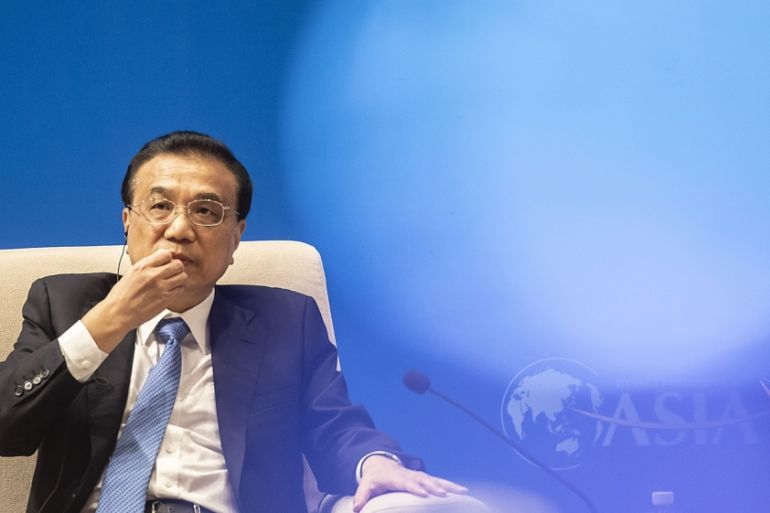‘Very difficult’ for China’s economy to grow at 6 percent: Li
Li’s comment that downward pressure is ‘certain’ for China is underscored by slowest industrial output in over 17 years.

Chinese Premier Li Keqiang said it is “very difficult” for China‘s economy to grow at a rate of 6 percent or more because of the high base from which it was starting and the complicated international backdrop.
The world’s second-largest economy faced “certain downward pressure” due to slowing global growth as well as the rise of protectionism and unilateralism, Li said in an interview with Russian media which was also published on the Chinese government’s website.
Keep reading
list of 4 itemsBoeing hit with 32 whistleblower claims, as dead worker’s case reviewed
US imposes new sanctions on Iran after attack on Israel
A flash flood and a quiet sale highlight India’s Sikkim’s hydro problems
China’s gross domestic product (GDP) grew 6.3 percent in the first half of the year, and Li said the economy was “generally stable” in the first eight months of the year.
“For China to maintain growth of six percent or more is very difficult against the current backdrop of a complicated international situation and a relatively high base, and this rate is at the forefront of the world’s leading economies,” Li was quoted as saying.
Analysts say China’s economic growth has likely cooled further this quarter from a near 30-year low of 6.2 percent in April to June. Morgan Stanley says it is now tracking the lower end of the government’s full-year target range of about six to 6.5 percent.
In response, the authorities have increased support, announcing on September 6 a cut in the reserve requirement ratio (RRR) for the third time this year, releasing 900 billion yuan ($126.35bn) in liquidity into the economy.
Industrial output growth underperforms
China’s industrial production growth skidded to its weakest pace in 17 years and a half in August, expanding by just 4.4 percent year-on-year, signalling further weakness in an economy hit by the trade war and slowing demand.
This fell far below expectations, as analysts polled by the Reuters news agency had forecast industrial output would rise by 5.2 percent from a year earlier, a slight rebound from the 17-year low of 4.8 percent in July.
August’s figure is the slowest since February 2002.
Spending on things like equipment, land and buildings – known as fixed-asset investment – for the first eight months of the year rose by 5.5 percent, according to data published by the National Bureau of Statistics (NBS), compared with a 5.6 percent rise forecast by analysts.
Private sector fixed-asset investment, which accounts for about 60 percent of the country’s total investment, grew by 4.9 percent in January-August, compared with a 5.4 percent rise in the first seven months of 2019.
Retail sales growth slowed to 7.5 percent, compared with 7.6 percent in July. Analysts surveyed by Reuters had expected growth of 7.9 percent.
Growth in China’s property investment also cooled, growing by 10.5 percent in the first eight months of 2019 from a year earlier, official data showed on Monday. It grew by 10.6 percent in the January-July period.
For January-August, property sales by floor area fell by 0.6 percent compared with a 1.3 percent drop seen in the first seven months, the NBS said in a statement.
A robust real estate industry has helped China counter a broader slowdown in the manufacturing sector and consumer demand as well as a protracted trade war with the United States.
While Beijing has stepped up efforts to stimulate the economy, it has not loosened regulations in the property sector that were put in place to curb speculation. The ruling Communist Party has said it will not use the market as a form of short-term stimulus.
Price trends have been mixed lately, with some cities showing signs of rapid cooling while others are plagued with overheating risks.